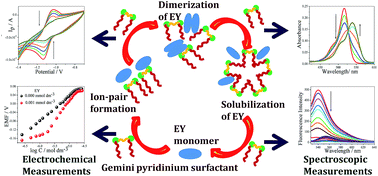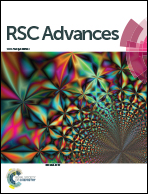Detailed study of interactions between eosin yellow and gemini pyridinium surfactants†
Abstract
Interactions of dianionic dye, eosin yellow, with gemini pyridinium surfactants, 1,1′-(2-hydroxypropane-1,3-diyl)bis(3-(tetradecyloxy)pyridin-1-ium) bromide [14-3(OH)-14] and 1,1′-(2-hydroxypropane-1,3-diyl)bis(3-(hexadecyloxy)pyridin-1-ium) bromide [16-3(OH)-16], have been investigated using conductivity, UV-visible, fluorescence, cyclic voltammetry, differential pulse voltammetry, potentiometry and dynamic light scattering techniques. Micellar, thermodynamic and electrochemical parameters have been evaluated using conductivity and voltammetry. The critical micelle concentration of both the gemini pyridinium surfactants decreases in the presence of dye. The formation of dye-surfactant ion-pairs and premicellar dye–surfactant aggregates in the sub-micellar region of gemini pyridinium surfactants has been observed and their stoichiometry was determined using conductivity and UV-visible techniques. Dynamic light scattering measurements provided information regarding the size of aggregates in pre- and post-micellar region of gemini pyridinium surfactants in the absence and presence of dye. Quantitative evaluation of the interactions among dye and gemini pyridinium surfactants has been done in terms of quenching and binding parameters using fluorescence, UV-visible and voltammetry techniques.


 Please wait while we load your content...
Please wait while we load your content...